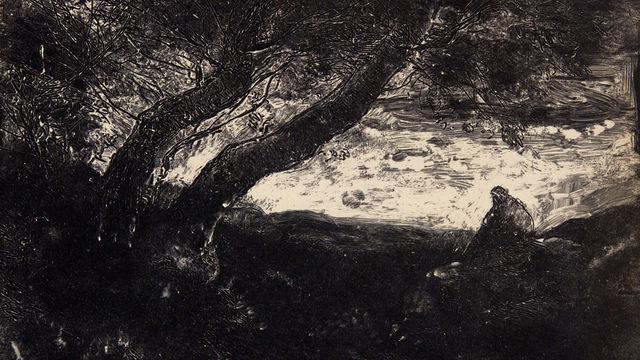
A Shadow’s Depth: From Etching to Charcoal
Each fall, the Grunwald Center for the Graphic Arts selects a small group of UCLA undergraduate art history majors to participate in a special independent study exploring the history of printmaking in the western world. Drawing primarily on the center’s remarkable collection of over 40,000 objects, this unique opportunity offers students hands-on experience handling, examining, and cataloging works on paper while also learning more about the cultural context in which these objects were produced. Taught jointly by Cynthia Burlingham and Leslie Cozzi, the Grunwald Center’s director and curatorial associate, the 2016 course focuses on innovations in 19th century printmaking and related arts. Complementing their other course work, this student-authored blog series presents reflections on some of the most significant artists and artworks of the period while providing our visitors unique insight into treasures of the Grunwald Center collection.
For more information on the Grunwald Center Research Internship and how to apply, please visit the “In Partnership” section of the UCLA Art History department website.
Flickering leaves, calm waters, silent forests—these natural phenomena found themselves on the industrial metal plates of French artists in the 1860s. Artists like Jean-Baptise-Camille Corot (1796-1875), Charles-Émile Jacque (1813-1864), and Maxime Lalanne (1827-1886) took to etching gusts ruffling up leaves into a blurry brush, the cold shadows of tall trees, and other landscape scenes in outskirts of the country. Along with the rediscovery of Rembrandt’s prints, the 16th century Dutch artist spurred many artists like Jacque to create what Hendrix calls in her catalog article “Landscape, Charcoal, and the Etching Revival” nocturnal dreamscapes.1 Rembrandt’s ability to render darkness radiant illuminated etchers’ interest in the tonality and nuance of shadow—urging landscape scenes to become a ground for experimentation in both etching and charcoal practices.
As the subject of the etching revival, nature, usually an academic and conservative subject, was also at the forefront of a material revolution. Charcoal, an existing but mostly preparatory medium, was christened into the realm of fine art, firstly by its acceptance as drawing in 1863 at the École des beaux-arts, and secondly by the production of fixative.2 No longer a temporary mark on paper, charcoal could be drawn, brushed, smeared, stumped, layered, scratched, and after a shellac-based fixative was applied, made permanent.3 The paper would turn golden brown soon after it was fixed, a color that became desirable to depict the ambience of crepuscular backlighting.4 In addition to spotlighting a subject or rendering the scene in chiaroscuro, charcoal can depict the raking light that shines through the subject, glistening through the leaves in Auguste Allongé’s Forest Interior and a River (1868) or bouncing on the water up at the shaded viewer in Adolphe Appian’s Forest Interior with a Pond (1885). Specifically, fixative made possible the application of powdered charcoal, a material that Lalanne uses to instill gusts of wind in Castle Overlooking a River. It no longer was solely a world for graphite, ink, and paint, now there was a medium of particulates—now the artist created clouds made of actual material dust that would not flit away, but were everlasting.

Artists like Jean-Baptiste-Camille Corot were both etchers and fusainistes.5 Etching The Dreamer in 1854 on wove paper, he later draws the same subject in charcoal on brown paper. Both prints show a solitary man in a nocturnal landscape, facing two prominent twisting tree trunks that extend towards him in a looming manner. The etching, with its short scratches for tangled branches and tense slices for clouds, has a melancholic intensity to it. If the landscape is a window into the thoughts of the dreamer, the etching and the fusain would dream different scapes. In his charcoal iteration of the subject, the man appears to be less hunched over, the trees less ominous. Instead of melancholy, the dreamer contains himself in his solitude though surrounded by the bending world around him. The branches are not necessarily attached to the trunks, but float to take on the role of the wind, the leaves and the overall movement of the piece. These branches’ forms echo the hill he sits on and the sky he’s under. No longer dependent on the line, charcoal became form.

In their focus on landscape and interest in shadow, etching and charcoal informed each other in this revival of the 1860s. Art supply stores began fervently advertising new papers and materials, treatises were written on the application of charcoal, and overall, art making became more accessible.6 Charcoal renewed artists’ interest in Rembrandt-esque light and generated nuance in both form and tonality. In its shadows lay a new emotional response that could be soft and contemplative opposed to the naturally sharp line of pen or etching. Because of the new possibilities of this medium, the otherwise conservative subject of landscape lent itself to abstraction, surrendering its lines for the deep forms of shadows.
[1] Lee Hendrix, “Landscape, Charcoal, and the Etching Revival,” in Noir: The Romance of Black in 19th-Century French Drawings and Prints, 32.
[2] Hendrix, 33.
[3] Ibid.
[4] Hendrix repeats the word “crepuscular” often in her discussion of noir prints to describe the specific sight of streaming backlight. Hendrix, 33.
[5] Charcoal draftsmen.
[6] On page 35, Hendrix cites Lalanne’s Le Fusain (1869), Allongé’s Le paysage au fusain (1876), and Georges Meusnier’s Le fusain sans maître: Traité pratique et complet sur l’étude du paysage au fusain (1875).




